These three-pedal bruisers are a dying breed
Until the 1960s, big, brawny, front-engine GT cars were the gold standard. On the Autostrada or the Autobahn, a powerful two-seater or 2+2 coupe was a viable alternative to a light plane. With a big Ferrari, Aston, or Maserati at your disposal, you could have breakfast in Marseille and dinner in Munich without breaking a sweat. The advent of mid-engine cars like the Lamborghini Miura and Ferrari Berlinetta Boxer blunted the top-dog status of the front-engine GT, but the sheer practicality of this classic layout meant that the genre persisted for decades.
Alas, the three-pedal GT is all but extinct and destined for a fast-track to collector status. Here are some of our favorites from the last 20 years, some of the last of their kind. They’re bargains (for the moment), even in spite of the frothy post-pandemic market.
2005–17 Aston Martin V8 Vantage
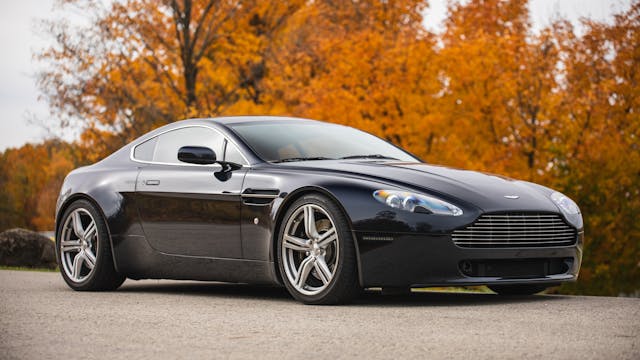
Since the introduction of the DB7 in the late 1990s, Aston Martin has been on a roll, producing one gorgeous car after the next. Of Aston’s modern lookers, though, the V8 Vantage and DB9 of the 2000s might be the high-water mark. Both are timelessly gorgeous, with ample modern performance to match. In Road & Track’s first road test of the V8 Vantage, the magazine called it one of the sexiest-looking cars on the planet with an exhaust note to match. Handling is superb with great balance, and Aston built in a ton of safety, even with the driver’s aids turned off. With 380 hp from a 4.3-liter dry-sump V-8, 0-to-60-mph comes up in 4.7 seconds. From 2009 the engine grew to 4.7 liters for 420 horses. A V-12 model was also available from 2009 on, but the V-8 cars are much more affordable, simpler to maintain, and just as nice to look at.
With its handy hatchback, the two-seater Vantage had more cargo space than the longer-wheelbase (but mechanically similar) DB9, which had a pair of small back seats. Maintenance costs are, well, befitting of the car’s exotic status, but with condition #2 (Excellent) values ranging from $54,000 to mid-$60K territory for most base-model V-8 coupes, the Vantage is an über-sexy car for the money as well as one that is likely done depreciating.
2014–19 Chevrolet Corvette (C7)
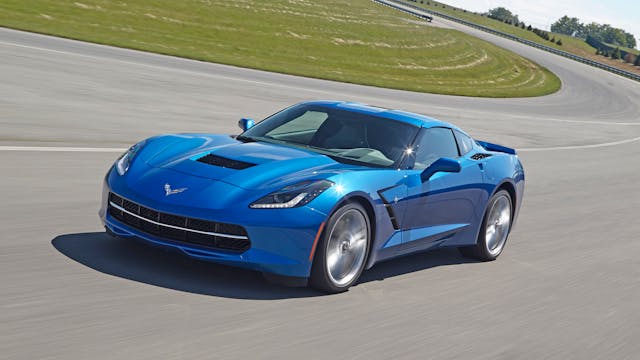
As the last front-engine Corvette (and the last one with an available manual), the C7 will always hold a sweet spot in the hearts of Corvette fans. As the truly spectacular car that it is, the C7 has enough going for it to tempt decidedly non-Corvette people, too. The car checks nearly every box—V-8 bellow, enviable Le Mans GT class history (thanks to the Pratt and Miller–prepared C7.R racers), and even an interior that feels far less downmarket than the Corvettes that precede it. C7 manuals have also acquired an impressive track record when it comes to reliability.
The dirty little secret of C7s is the fact that the base cars might just be the most satisfying ones to drive on a daily basis. The stock suspension and brakes work great for real-world driving, while 455 hp and 460 lb-ft from the base V-8 will rarely leave you yearning for more grunt. If you do some occasional track time, the Z51 package is wonderful, adding bigger Brembo brakes, performance exhaust for added sound and another 5 hp, an electronic limited-slip differential, and optional Magnetic ride control. With another 200 hp or so, the Z06 is an impressive car, but even with driver’s aids on, it can quickly tax the abilities of all but the most skilled drivers.
While C7 base cars have depreciated very little from their original price off the lot, they still offer more speed per dollar than almost anything on the road. They’re a screaming bargain in the high-$30,000 to low-$40,000 range.
2015–19 Jaguar F-Type
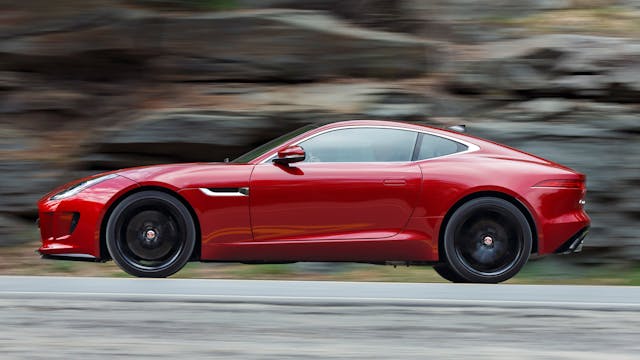
Ever since 1961, Jaguar has been trying to recapture the magic of the original E-Type. For the most part, the company has failed, but its latest attempt got closer than all the rest. Introduced in the spring of 2014, the F-Type was audaciously named as the direct lineal descendent of the E. And it is gorgeous, albeit not in the same sensational way that the E was at the Geneva Motor Show back in 1961. But other than low-volume exotic stuff like the XJR-15 and XJ220, it is the prettiest sports car Jaguar has produced since the E-Type.
And while the V-8 F-Types have the most intoxicating exhaust notes, and more power, it’s only the odd V-6 (essentially the V-8 block with two empty cylinders) that came with a manual transmission. It’s a low-key, elegant car that is quite reminiscent of a 1960s GT car, and decidedly off-brand for Jaguar. The F-Type also has a pretty good reputation for reliability, as Jaguars go. Jaguar didn’t release production figures for the manual (which disappeared after 2019), but at any given time, there are maybe two or three F-Type manuals for sale nationally, and that kind of rarity translates to solid potential for long-term collectability.
2002–07 Maserati Coupe and Spyder
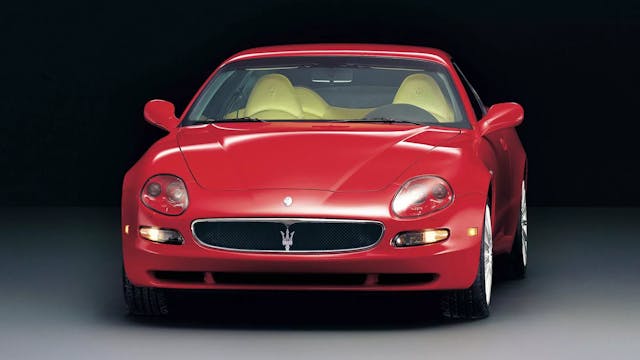
These two cars led Maserati’s resurgence in the U.S. as the first new Masers sold here since the wedgy/boxy Biturbo series of the 1980s and early ’90s. Neither the 2+2 Coupe, nor the shorter-wheelbase Spyder represented Italdesign’s/Giorgetto Giugiaro’s most striking work, but both were understated and handsome, and powered by a 4.2 liter, Ferrari-derived 385 hp V-8. Both available gearboxes were six-speeds, with one being a conventional three-pedal affair, and the other a two-pedal Cambiocorsa, a manual with an automated clutch. The former accounts for roughly ten percent of production and is far more desirable than the Cambiocorsa, which has a reputation for electrical and hydraulic problems. It likes to eat clutches, and the shifts are generally clunky.
Cambiocorsa values have accordingly taken a huge hit, which, to an extent, has driven down manual prices. Nice Coupes and Spyders can be had for well under $40,000. For a Giugiaro-designed Italian exotic with the heart of a Ferrari, that’s a serious deal.
2003–10 BMW 6 Series
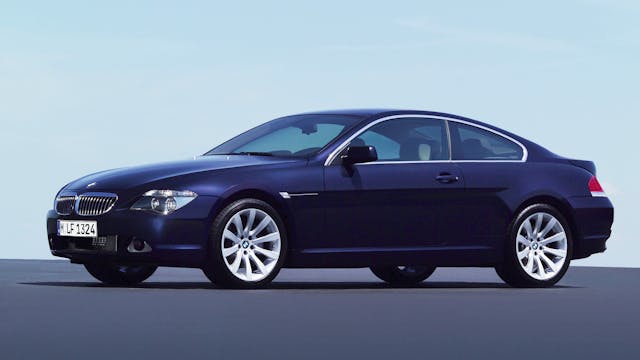
If there’s a bête noire of automobile designers, it’s Chris Bangle, BMW’s chief of design during the 1990s and 2000s. Given the current vandalism that is taking place throughout the BMW lineup, however, some of Bangle’s designs like the E63/E64 6 Series and the Z4 Coupe are starting to look quite a bit better, “flame surfacing” and “Bangle Butts” notwithstanding. Truth be told, the E63/64 were actually finalized by Adrian van Hooydonk; but since they were based on a Bangle concept, Chris generally gets the blame/credit.
Introduced in 2003 after the original was discontinued in 1989, the second-generation 6 Series rides on a shortened version of the E60 5 Series platform. Wonky iDrive interface aside, these aren’t bad cars. The naturally aspirated N62 V-8 was the first to use a continuously variable-length intake manifold to go with variable valve-timing. The 4.4-liter 645Ci made 329 hp, and its replacement, the 4.8-liter unit found in the 650Ci, made about 33 more. Both engines require proper maintenance, and both still suffer from the usual BMW maladies like oil leaks and faulty valve-stem seals. But most importantly, coupes and convertibles were classic GTs and both could be had with a manual transmission. Manual 6 Series are rare but worth looking for, and probably won’t get any cheaper than they are now.
***
Check out the Hagerty Media homepage so you don’t miss a single story, or better yet, bookmark it. To get our best stories delivered right to your inbox, subscribe to our newsletters.
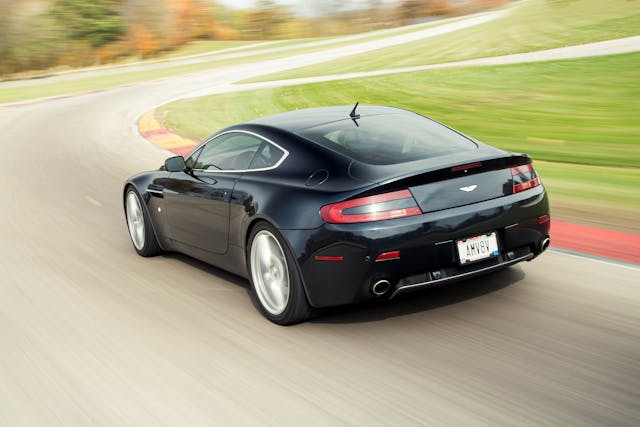


I would include the current Mustang. I have a tuned 2016 GT with the six speed with the Ford performance shift kit. Great Car and the only reasonably priced one here
I love Mustangs, too, and have a GT with the manual transmission – but the Mustang is not in the same league as these grand-touring cars. Which, of course, is good for those of us that cannot afford an Aston or such.
Agreed, but mine doesn’t cost two grand to do a brake job and parts are readily available. I drove a number of Ferraris in the 70s and 80s, tuning six Weber’s on a Daytona was like tuning a Stradivarius. And my stage two Mustang burns up Sears Point and Thunderhill along with the hyper expensive Porsches and a lone McLaren……LOL
Cheers, (BTW- GM is cancelling the Camaro next year……(LMAO)
You may have missed the point entirely, Toby. Bet you won’t miss the crowd! Classic Mustang move.
I really hate CVT’s and the ‘modern’ automatics. Expensive junk. I could usually beat the EPA listing on anything I had that had a manual so the ‘gas mileage’ advantage of these new transmissions rings hollow for me.
I don’t think you’re considering modern 10 speed autos, or DCT’s, as you won’t be out-shifting them OR being more miserly with your fuel.
I love Mustangs, too, and have a GT with the manual transmission – but the Mustang is not in the same league as these grand-touring cars. Which, of course, is good for those of us that cannot afford an Aston or such.
That was then, this is now. Very few manuals of the past several years could out-accelerate or out-MPG their automatic brethren. The current Subaru BRZ is one of the few that are quicker, per mag tests. Modern automatics usually have 8 to 10 gears, and (generally) very effective electronic controls. Very few manuals have more than 6 speeds.
I think is is rather odd to skip over the under-appreciated 1996-2015 Jaguar XK8/R in this list which was also announced as the direct descendent of the E-Type when it came out. To me it looks more like the E-Type than the F does.
You could not get the Jag XK8/R with a manual transmission. I’ve heard of a few converted but those are home-built. I’d love a XKR with a manual. We own a XKR and that is the missing piece.
CTS-V! Great all around car!! I miss mine terribly!!!
From my three on the tree to the four on the floor noting beats a standard shift. Got so that I could shift without the clutch by just the sound and RPM. Sure miss that and my grandkids might never know the joy of shifting.
I fell into the same trap … calling Manual shift “standard”, haha. Now Auto is “standard”.
I have been having great fun teaching my grandkids to drive manual trans cars … sincerely hope you have a chance to do the same. Maybe it’s our responsibility as grandfathers! SAVE THE MANUALS!
The “good” thing is that almost no one steals manual Transmission cars – they can’t figure out how to drive them
Excellent and accurate point!
Of course, if you were inclined to valet park your vehicle, most in my area have a sign posted, “No manual transmissions” LOL. You would think that ability would be part of the job requirements.
Touché I love it, I rather park my car than have it valet parked anyway. Been the sole driver of my manual 2000 BMW since new.
Next thing you’ll be doing is teaching them cursive handwriting! Love it!
From one Grandfather to another – AMEN.
Personally I think you missed one. The Mitsubishi 3000 GT VR4 (GTO) made from 1990 to 2000 (1991 to 1999 for USA market) was an amazing piece of automobile engineering. Twin Turbos, All wheel drive, All wheel steering, Active Aero ground effects, Tunable suspension, Tunable exhaust. With creature comforts like steering wheel radio controls and even built in garage door controls what more could you ask for? OK …How about the first hardtop/convertible retractable top on a production car since the 1959 Ford Skyliner. The Spyder was only made for two years & in limited numbers in 1995 & 1996.
5 spd Unicorn….I was lucky enough this year to purchase a one-family 1987 Lister Jaguar XJ-SC here in North Carolina that was converted by Lister North America when new. In addition to the suspension and aero upgrades, the SPECIAL SAUCE was the 5 Spd Getrag transmission matched with the 5.3 ltr V12 engine. The cost new in 86-87 was about $65k and was more expensive than the 928S. Lister North America only did about 20 of the “full Lister conversion” cars. so they are rare and I’ve tracked down 4 other 5 spd V12’s from LNA. Due to the US Gov’t emissions requirements in the 80’s, the engines were mostly left alone, but the addition of the 5 spd beautifully changes the disposition of the car. Smiles for miles.
So where’s the Viper- I’d think that would fit this description.
I completely agree. I always wanted a 1995 in black with the tan interior. Bad ass cars!
More of a hard-core sports car, I would say, than a grand-tourer.
I can’t believe that you didn’t include the Pontiac GTO! You know G. T. O.? The 2006 was a great long-distance grand tourer. They were undersold by GM and styling was understated so they didn’t sell well but if you actually drove one you wouldn’t every want to give it up. I did and have forever regretted it.
Comfortable seats… slick 6 speed manual …. 400/400 power… you could drive all day and step out refreshed!
True Grand Touring cars are the absolute best in my opinion: power, looks, comfort, etc… can’t beat it.
I had a 2006 GTO also. I’ve always been a stick guy but I got so tired of shifting that 6 speed that I finally sold it. It just seemed like it was never in the right gear. If it had been an automatic I would probably still have it. Not really a good looking car but ran like a banshee. Guess I’m just getting too old 🙂
In addition to my daily driver, a 2010 Camaro SS with the six speed manual, I was fortunate enough to score a very low milage 2017 Chevrolet SS four door sedan, six speed manual back in 2020.
With the LS3 (415 HP, 415 TQ), 3:70 rear and three suspension settings, that car is a blast to drive.
I’m guessing that you have probably never driven a Porsche PDK.
Nope still prefer my MT Carrera 4S
This is totally ignoring the EPA Manual transmission penalty that auto makers install at the factory in the form of an awful final drive unless you get the automatic. Then again you could get a Miata because Mazda for some reason gets it and doesn’t hobble that car.
Ever since 1961, Jaguar has been trying to recapture the magic of the original E-Type.
Scratching my head over that comment since that magic ran from 1961 to 1974.
That’s because after 1961 they would have to start working on a worthy successor even if the original was still in production.
For me it is not about speed or gas mileage. It all about FUN !!! ………Jim.
Challenger? It’s more of a grand tourer than a Mustang or Camaro.